|
| |||||
| |
|||||
| |||||
- Research Provides New Insight Into RNA Polymerase Dynamics
- Washington Report
- Darleane Hoffman Wins Priestley Medal
- Berkeley Lab Acts to Address Tritium Questions
- Lab Scientist Featured in NOVA/ FRONTLINE Special
- Berkeley Lab Currents
- Synchrotron Takes Aim at Live Cells
- ASD Appoints New Department Head
- Open House 2000
- Bulletin Board
- Calendar of Events
- Nominations for Outstanding Science and Math Teachers at Open House
- Flea Market
Recommitting Ourselves to a Diverse Work Environment
By Charles V. Shank

|
As I take stock of our progress in this area, the picture that emerges is not a comfortable one. Earlier this week at the Diversity training session I pointed out that we are not yet in a position to call ourselves a leader in creating a diverse work environment. I believe we can do much better. Our goal should be to set an example for the rest of society.
Over the last eight years, minority representation in the workforce has not budged from a level of about 26% and female representation has been stuck at around 31%. Whatever we have been doing, we have not changed the makeup of our laboratory.
So how do we change things for the better? The first thing to do is to raise the level of dialogue and attention to this topic, and for the last several months I have been having extensive discussions with the Division Directors. I have also benefited from talking with members of Berkeley Lab's Diversity Committee. Among the conclusions I have reached is that all of our divisions must be part of the solution. Starting this year I am asking that each division create a Diversity Plan to advance the cause of diversity. I will review these plans with the help of Deputy Directors Pier Oddone and Klaus Berkner.
A division's Diversity Plan should address two main elements that are closely tied together. First, we should take innovative actions to enhance the work environment for all our employees. The greatest recruiting tool for expanding our diverse work force is an employee who feels well supported. Second, we should take steps to ensure that our hiring pools are as diverse as possible. Toward this end, the Human Resources Department has established a new recruitment office to support divisions in developing diverse hiring pools.
I invite you to contribute your thoughts and ideas to your Division Director in order to make these plans effective tools for advancing the cause of workforce diversity.
Of course, we need to continue our efforts to expand the pipeline of minority students in education and with access to our Laboratory. Our school-to-work program and increased participation by our staff in mentoring community college and undergraduate students contributes as well to our work environment.
I thank you all in advance for joining me in this recommitment to making our Laboratory a shining beacon of which all parts of our community can be proud. It is a privilege to be a part of an institution like ours. We must strive to be inclusive of all the elements of the society that supports the work we do.
Open House 2000 set for May 6
Come for the science and stay for the fun
Mark your calendars for Saturday, May 6, to take part in Berkeley Lab's Open House and Science Festival. This year's event promises to be better than ever, with a variety of new attractions and special activities. The day kicks off at 10 a.m., and will feature hands-on science, a job fair, food, music, and--as those of you know who have attended previously--more than you can possibly see and do during the six-hour event.
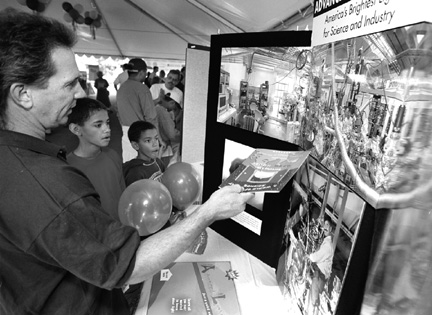 |
Our festival this year will include multiple attractions for Bay Area students of all ages, as well as their parents. Among the special events is a very special preview screening of Michael Apted's film, "Me & Isaac Newton," a celebration of the lives of seven exceptional scientists, including Berkeley Lab's own Ashok Gadgil. Also, in the spirit of the Lab's longstanding mission to support science education, there will be an event honoring local science and math teachers who have served as an inspiration to their Bay Area students.
This year's Open House will focus on four theme areas: Home and Environment, To Your Health, World at Your Fingertips, and Universe in Your Pocket, along with the always popular Family Science Tents for children from preschool through elementary school. There will be tours of the Advanced Light Source, the National Center for Electron Microscopy, and the 88-inch Cyclotron, along with an amazing array of demonstrations and exhibits that bring to life the Lab's mission of scientific exploration. For a complete description of Open House themes and activities see pages 4 and 5 of today's Currents. Plan out your visit in advance, and bring your family and friends for a day full of wonder and discovery.
Research Provides New Insight Into RNA Polymerase Dynamics
By Lynn Yarris
A team of Berkeley Lab and UC Berkeley scientists have reported the first direct observations of what happens when the message of a gene is read during the actual transcription of a single DNA molecule.
Using a unique experimental setup they designed themselves, the researchers followed transcription by single molecules of RNA polymerase (RNAP), the enzyme responsible for reading the genetic message in humans and other higher organisms as well as in bacteria. Their observations provide new insights into how genetic expression in cells may be regulated.
Carlos Bustamante, a biophysicist and UC Berkeley professor who heads the Advanced Microscopies Department for the Physical Biosciences Division, led the group that published the results in the March 31 issue of the journal Science. In addition to Bustamante, the authors were John Davenport and Gijs Wuite of UC Berkeley and Robert Landick of the University of Wisconsin at Madison.
Most of what we know about how the genetic messages stored within the DNA of a living cell are transcribed by the RNAP enzyme comes from "bulk experiments" performed on batches of molecules. Conclusions were based on averaging observations as if the activity of each molecule in the experiment were the same--an iffy assumption, given the size and complexity of an enzyme like RNAP.
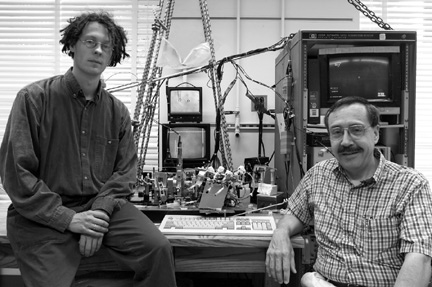 |
The Berkeley team made their observations using an "integrated laser trap/flow control video microscope," which was designed and built in Bustamante's laboratory. In this setup, a strand of DNA is tethered between two micron-sized polystyrene beads in the middle of a chamber, one bead anchored on the tip of a glass pipette and the other held by a laser beam in an optical trap. Controlling the exchange and flow of liquids through the chamber and manipulating the laser trap can then be used to apply force on the beads, and the results can be measured through video microscopy.
This unique experimental system enabled the researchers to make direct observations of the RNAP transcription process in real time over a long length of DNA (more than a thousand base pairs). Their spatial and temporal resolution was better than previous efforts, and they could record transcription events not only as a product of solution conditions but also as a function of applied force.
It was known that RNAP might pause during the transcription process at various points along the way for a few seconds or a few minutes. Transcription may even stop entirely, with the RNAP going into a state of arrest. In their Science paper, the Berkeley researchers report that the rate at which RNAP transcription took place would vary, but the variations were not associated with specific locations along the DNA. Rather, individual RNAP molecules would switch back and forth from transcribing at a faster or slower rate -- as if, Bustamante says, "they exist in different gears corresponding to different functional or dynamic states."
It was also observed that RNAP molecules transcribing at a faster rate are less likely to pause than those transcribing at a slower rate. The authors say this suggests there is a "kinetic competition" between transcription and pausing, which would mean that pauses are not intermediate steps in the transcriptional process but are a separate functional state that renders the molecule incapable of further transcribing.
Explains Bustamante, "Our observations are consistent with the idea that a paused RNAP molecule is not just stopped there, like at a traffic light, but has parked inside a garage and must be brought out of the garage to resume its movement."
Bustamante and his colleagues speculate that within a cell there may be other molecules that bind to the RNAP to stabilize its conformation, so that it transcribes at a faster or slower rate -- which in turn would make it more or less susceptible to pausing. This, they say, could be the basis for yet another level of transcriptional control and regulation. Future experiments are planned using an improved second-generation version of the integrated laser trap/flow control video microscope, now being built.
Washington Report
Art Rosenfeld Appointed to California Energy Commission (CEC)
Governor Gray Davis announced the appointment of Arthur H. Rosenfeld as a member of the California Energy Commission (CEC).Rosenfeld, 73 is the director of the Center for Energy and Climate Solutions, a non-profit agency in Annandale, Virginia. From 1994 to 1999, he was the senior advisor to the Assistant Secretary for Energy Efficiency and Renewable energy at the U.S. Department of Energy in Washington, D.C. From 1955 to 1994, Dr. Rosenfeld was founder and director of Berkeley Lab's Center for Building Science, and a professor of physics at the University of California, Berkeley.
At Berkeley Lab, Rosenfeld worked with the Nobel Prize winning group led by Professor Luis W. Alvarez until switching careers in the early 1970s to study energy efficiency. He was the founder of the California Institute for Energy Efficiency and was co-founder of the American Council for an Energy-Efficient Economy. He received the Star of Energy Efficiency Award in 1995, an award for outstanding contribution in promoting energy efficiency.
The CEC, (formally, the California Energy Resources and Development) is the
state's primary energy policy and planning agency, charged with ensuring a
reliable and affordable energy supply. This position requires Senate
confirmation.
- Allan Chen
DOE Releases Technology Roadmap for Lighting:
The Department of Energy has released "Vision 2020: The Lighting Technology Roadmap." Aimed at guiding the government and private sector in R&D for lighting technologies over the next 20 years, the report is being issued in conjunction with the opening of a new DOE-sponsored "Lighting a Revolution" exhibit at the Smithsonian Institution's National Museum of History.The report is somewhat critical in noting that lighting control technologies and systems are not standardized and that research is not coordinated in the basic science of commercial light sources, making it difficult to achieve major breakthroughs in lighting performance and efficiency. The full report can be viewed at http://www.eren.doe.gov/buildings/vision2020.
DOE Announces Major Changes to Improve NIF Management
Secretary of Energy Bill Richardson has announced management changes to strengthen DOE oversight of the National Ignition Facility at Lawrence Livermore National Laboratory. Richardson said the changes would address many of the shortcomings identified during the department's internal review of the project.
"I remain deeply disappointed at the manner in which these problems were
handled," said the Secretary in a press statement. "But I am also convinced
that the underlying science of the NIF remains sound."
- Lynn Yarris
Darleane Hoffman Wins Priestley Medal
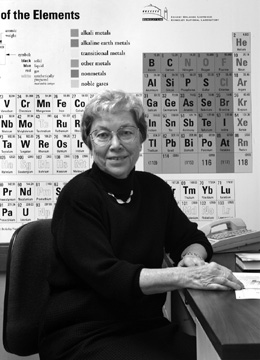 |
Hoffman's distinguished career in nuclear science began inauspiciously enough in 1946, while she was an undergraduate at Iowa State University. There she took a course in chemistry for home economics taught by "a wonderful woman professor named Nellie Naylor." The following year Hoffman was introduced to nuclear chemistry.
"We had a 68 MeV (million electron volt) synchrotron that was just being finished there," she says, "and so we could go and do experiments and find new isotopes. You had the thrill because you were seeing something that nobody had seen before!"
Hoffman switched her major from applied art to chemistry and never looked back.
Hoffman is now an internationally recognized expert in the study of transuranic elements -- chemical elements heavier than uranium -- and after nearly 50 years in the field, she still gets a thrill from her work.
"One of the reasons I don't really want to retire is that it's a very exciting time for both the nuclear and the chemical aspects of nuclear chemistry," she says.
This past summer, Hoffman was a member of the team that discovered elements 118 and 116. She called this discovery "one of the most exciting of my career" because the radioactive decay patterns of 118 and 116 provided strong support for the existence of the "island of stability" that theorists have long predicted for superheavy elements.
Hoffman also continues to enjoy teaching. "The more people you can teach about these things, the better educated the general public will be," she says.
--Lynn Yarris
Berkeley Lab Acts to Address Tritium Questions
By Ron Kolb
Berkeley Lab has taken several recent actions to answer questions involving the use of tritium in Laboratory research, in cooperation with the Berkeley community and the U.S. Environmental Protection Agency (EPA).
In order to address local concerns about the potential impacts on public health from radiation produced in scientific investigations, Laboratory Director Charles Shank has initiated the following:
- Convened the Environmental Sampling Project Task Force, a 21-member community advisory group to assist the laboratory in measuring levels of tritium in the soil, water, air, and vegetation
- Committed laboratory time and resources to assist City of Berkeley consultant Bernd Franke, who has been hired to respond to the Laboratory's sampling plan and evaluate past and present laboratory emissions
- Commissioned Dr. Ralph Thomas, an international expert on radiation safety, to address one of Franke's interests by conducting an historical survey of radiation generated at the Laboratory, in particular by the Lab's pioneering particle accelerators
- Hired Dr. Owen Hoffman, a nationally known environmental risk expert, to facilitate the acquisition and sharing of data and reports for the City of Berkeley studies
The Task Force will hold its third meeting on April 25 with special focus on a draft comprehensive sampling plan for measuring tritium in the environment. This plan will gather data that the EPA can use to evaluate the Laboratory's eligibility for EPA's National Priority List. Though all data gathered to date indicate the Laboratory is well within all federal and state public health standards, the EPA has requested additional measurements.
At the first meeting of the task force members in January, Shank told them, "The issue before us is, is there an imminent health danger in this community (from Laboratory tritium emissions)? We will provide data, conduct real measurements, and get the information for you. We will cooperate with all city and regulatory bodies."
For some time now, certain community representatives and city officials have expressed concern about the very small amounts of tritium that are emitted through research activities at the Lab's National Tritium Labelling Facility (NTLF). The NTLF conducts biochemical studies to create new radiotracers to analyze biological reactions at the cellular and molecular levels.
The Task Force was formed to engage community stakeholders in the process of tritium sampling and its evaluation so that concerns about public health can be answered. A 1997 Health Risk Assessment conducted by the Laboratory, based on the Lab's own monitoring, has shown that annual air emissions from the NTLF result in off-site radiation doses that are less than two percent of the EPA's acceptable public health standard.
In response to community concerns, however, the City of Berkeley hired Franke, of the German environmental consulting firm Institut fur Energie und Umweltforschung (IFEU), to do an analysis of all reports and data concerning tritium and radiation exposure. In recent meetings at the Laboratory, Franke conveyed his needs, and Laboratory staff began the process of collecting requested information.
Hoffman, President of SENES Oak Ridge, Inc., Center for Risk Analysis, of Tennessee, brings more than 25 years of experience as an environmental scientist specializing in human dose and risk evaluation for radionuclides and chemicals to his consulting role for the Lab. Hoffman will work with Franke on data collection and interpretation.
Thomas earned his reputation as a pioneer in the field of radiation safety for particle accelerators. He recently chaired a Joint Task Group of the International Commission on Radiological Protection and the International Commission on Radiation Units and Measurements to produce a definitive report on radiological protection against external radiation.
Thomas worked at Berkeley Lab from 1963 to 1991 and served as Director of the Occupational Health Division, monitoring the operations of the Bevatron, Berkeley's historic synchrotron whose accomplishments over four decades led the frontier in the fields of high-energy and heavy-ion physics. Early discoveries at the Bevatron - or Bevalac, as it was called after its linkage with the SuperHILAC linear accelerator in the 1970s -- resulted in four Nobel prizes.
In accelerators such as this, the energizing of protons results in the emission of radiation in the form of neutrons.
In his analysis of historical radiation doses at Berkeley Lab, Thomas relied on public laboratory reports that showed the maximum potential annual dose off-site reached 820 millirem in 1959 when the maximum federal public safety standard was 1,500 millirem per year. His subsequent recalculations, based on modern conversion methods, have placed that 1959 figure at approximately 360 millirem.
Largely due to added shielding around the Bevatron, maximum potential doses in subsequent years dropped significantly, even as the beam intensities of the accelerator were increasing. The public records show that the annual measured radiation doses continued falling to below 10 millirem. Through the entire period of accelerator operations, maximum potential Laboratory radiation dose levels have always been below the federal safety limits in effect at the time, according to data in the historic published reports. Today's federal EPA safety standard for radiation from all sources is 100 millirem per year.
In 1999, site-wide, the Laboratory had a total maximum potential dose exposure at its perimeter for radiation from all sources of less than 1 millirem, which is substantially less than the effective dose equivalent received from a single dental x-ray (10 millirem).
Thomas' analysis, and the published reports from which his analysis was drawn, have been forwarded to Franke for his review.
All records of the Environmental Sampling Project Task Force, including transcripts of meetings, can be found at www.lbl.gov/ehs/tritium/.
Lab Scientist Featured in NOVA/ FRONTLINE Special
Berkeley Lab researcher Jonathan Koomey of the Environmental Energy Technologies Division discusses climate change and energy use during a two-hour special presentation combining two of public television's most popular programs. NOVA and FRONTLINE join forces to investigate global warming in a program titled, "What's Up with the Weather?" airing Tuesday, April 18, from 9 to 11 p.m. on PBS stations (check your local listings). The special examines both sides of the global warming debate, interviewing scientists, policymakers and fuel industry representatives with different viewpoints on the contentious climate issue. For more information on Koomey's research, see http://enduse.lbl.gov/. The NOVA/Frontline Web site for this show can be found at: http://www.pbs.org/ wgbh/warming/.
Berkeley Lab Currents
Published twice a month by the Public Information Department for the employees and retirees of Ernest Orlando Lawrence Berkeley National Laboratory. Ron Kolb, PID department head.
EDITOR: Monica Friedlander, (510) 495-2248, msfriedlander@lbl.gov
STAFF
WRITERS: Paul Preuss, 486-6249; Lynn Yarris, 486-5375
CONTRIBUTING WRITERS:
Jon Bashor, X5849; Allan Chen, X4210, Jeffery Kahn, X4019
FLEA MARKET / CALENDAR: 486-5771
fleamarket@lbl.gov / currents_calendar@lbl.gov
Public Information Department, Berkeley Lab, MS 65A
One Cyclotron Road, Berkeley CA 94720
Tel: 510/486-5771 Fax: 510/486-6641
Berkeley Lab is managed by the University of California for the U.S. Department of Energy.
Synchrotron Takes Aim at Live Cells
By Paul Preuss
A bright, tightly focused beam of infrared light from the ALS's beamline 1.4.3 allows researchers to follow subtle chemical and molecular changes in individual human cells, without killing the cells or using intrusive probes.
Traditional methods of biomedical research require killing cells (fixing them), averaging results from many cells, or introducing dyes, tagged proteins, or other agents that can affect cell chemistry--methods that involve tedious preparation and long delays between experiment and result.
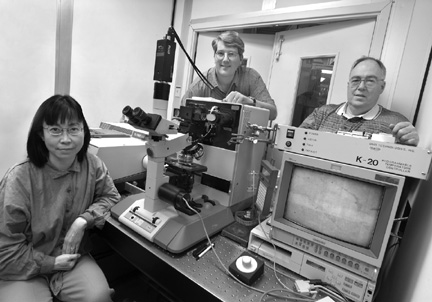 |
Holman and her colleague Michael Martin of the ALS described the technique, known as Synchrotron Radiation-Based Fourier Transform Infrared spectromicroscopy, at recent meetings of the American Chemical Society and the American Physical Society.
Despite the jawbreaking name, the principle of SR-FTIR spectromicroscopy is straightforward. Different molecular and physical states of a cell absorb different wavelengths of infrared light, yielding unique spectra that can distinguish different cell types, different phases in the cell cycle, and different chemical reactions and physical changes inside the cell.
Light from the infrared beamline is hundreds of times as intense as conventional infrared sources and can be focused to a spot less than 10 micrometers in diameter, smaller than the dimensions of a typical mammalian cell.
"We can position the spot on a sample within one micrometer," says Wayne McKinney, who developed the beam line with Martin. He adds that "because the synchrotron light comes in pulses two nanoseconds apart, we can record very fast changes in cells." Although this capacity has not been applied to work done so far, it promises to open new insights into cellular processes.
So far, Holman and her collaborators have concentrated on the response of cultured human cells to low doses of environmental agents. In lung cells, they have shown that different oxidizers and x-rays produce different kinds of damage marked by distinct spectral changes. In liver cells, their work indicates that dioxin's influence is related to its interaction with a specific binding site.
They have also recorded distinctive spectra from lung cells going through different stages of the cell cycle. With other researchers, they plan to study radiation and drug therapies for brain tumors and oxidative stress in such diseases as atherosclerosis, diabetes, and rheumatoid arthritis.
SR-FTIR spectromicroscopy allows studies of live cells impossible or impractical by any other method, enabling basic studies of the life, death, damage, and self-repair of tissues and cells at the subcellular level.
ASD Appoints New Department Head
By Ron Kolb
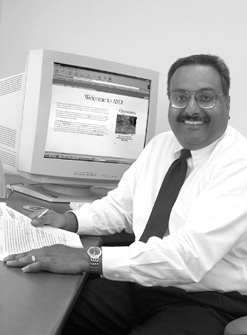 Photo by Roy Kaltschmidt
|
When the Department of Energy's "Tiger Team" safety inspectors came calling in the early `90s , Moré was named Budget Manager for Environment, Health and Safety, which subsequently grew from 50 employees to about 150.
In 1995, Moré was asked to coordinate the logistics of the move of the National Energy Research Scientific Computing Center (NERSC) from Livermore to Berkeley Lab. He set up the office budget system and staff to manage the $100 million operation.
And when the Laboratory's institutional budget manager departed in 1997, Moré stepped in and took on responsibilities that included oversight of the laboratory's $346 million budget.
"I like to fix problems, to bring people together and make things work," he says. "I'm not a strong maintenance person."
About seven years ago, Moré began working with then-Manager for Administration Cheryl McFate on implementation of a concept that would maximize administrative support services and share resources within a constrained financial environment within Operations. This evolved, in 1996, into a Laboratory-wide organization called the Administrative Services Department (ASD), whose ambitious goal was to provide seamless services across organizational lines, end duplicative systems, and build uniform standards and expectations in areas such as office management and support, finance, human resources, procurement and inventory, and work support.
Now, after three years of promising development -- and the inevitable growing pains -- ASD enters the new century with a new vision and an invigorated future. And Berkeley Lab has turned to its ultimate "firefighter," Moré, to stabilize and steer it as Department Head.
Sitting in his new office in the downtown business center at Building 937, Moré reflects upon the accomplishments to date in ASD and the challenges this 375-employee unit faces in its next phase of development.
"We achieved some great things in our first years," he said, crediting ASD's inaugural manager, Meredith Montgomery. He noted the development of management clusters serving related research areas, improved performance review and salary-setting procedures, standardized administrative procedures lab-wide, an effective "flywheel" concept for short-term service needs, and improved career development opportunities for ASD staff.
On his whiteboard, Moré points to the lingering issues that he's been asked to address. At the top is "administrative assistant," employees who constitute three-fourths of the ASD workforce. With a 14 percent vacancy rate at present, recruitment in a competitive market is a top priority.
"Training is another issue," he said. "Some get it, some don't. We have, or will be getting, new (data) systems, and we need to train people on how to use them at the desktop."
He talks hopefully about integration -- bringing human resources and financial services together -- and enhanced communication at all levels. Moré's first "Level One" communique to ASD personnel in his new role announced his intention to strengthen intra-departmental ties through open communications, frequent updates, and periodic "town hall" and group meetings to broaden dialogue.
"We're here for the scientists," Moré says of the underlying mission of ASD. "How can we best provide administrative services to match the world-class science here? Scientists shouldn't have to worry about how it's done; they needn't care. The product will just be delivered, efficiently and economically."
In three years, he says, he'd like to see "a much more focused, integrated, seamless organization."
And Moré knows how it's done. He was the central player in another successful model -- the General Sciences and Directorate administrative team in Building 50. In two years as business manager there, he directed an administrative staff of 70 across major functional areas, setting up "centers" for human resources, budget and business processes. Division Directors were co-located in one suite to facilitate resource sharing and realize economies of scale. The transformation has received high marks from General Sciences Division directors.
Moré is the right man for the top ASD job primarily because of where he's been at the lab. He talks about the different perspectives that "central" and "field" experiences bring. Whereas central administration responds to the demands of the DOE and broad lab management, employees in department and programs ("the field") have more immediate concerns about local service delivery.
Moré has been in both, experiences which he says have been invaluable for him in assessing the needs of the department. One of the tensions inherent in the organization -- a perception that the central ASD office is the "police" -- should go away with Moré's administration. He has a lean and efficient four administrators working for him downtown, and he says, "Decisions should be made in the field. We (central) will only be involved if we can add value. It all has to be customer-focused."
Now he's hard at work on a shared vision for ASD, which he hopes to deliver to management later this spring. And that's a long way from tagging property, which was his first job at Berkeley Lab as a summer student in 1981. He was in business school at Menlo College at the time, and thanks to his father's successes in the facilities department here, Anil decided to check out the place on his own. He never left, working right through an MBA in finance, with the Lab's assistance, from Golden Gate University in 1983.
Vish Moré, his dad, is notable as the project manager for two of Berkeley Lab's prize buildings -- Building 2 and Building 66. He retired a few years ago after 15 years at Berkeley and 25 years at DOE facilities, including Abbott Lab in Illinois, Livermore and the Stanford Linear Accelerator Center.
"I like to think I'm carrying on the family name," Moré says proudly.
Open House 2000
Four themes . . . Many of the attractions at this year's Open House are tied to four themes that reflect our main areas of research at Berkeley Lab. Focus your stay at the Lab on a single theme by visiting the corresponding hub and the outlying attractions related to it. Or just pick and choose among the smorgasbord of attractions.
 |
 |
 |
 |
1. Welcome Center and Job Fair. General information, food, entertainment, and an overview of Laboratory activities. The Welcome Center is the place to start, whether you choose to follow one of the scientific themes, or create your own itinerary.
2. Family Science Tents. Activities for kids of preschool and elementary school ages. The "For Kids'" section on the opposite page offers details on these and other events for children.
3. Special Events in the Main Auditorium. The Science Discovery Theater, presented by the Lawrence Hall of Science, and a special preview screening of a film by Michael Apted. Details under Special Events.
4. NERSC and the Building 50 Complex. Supercomputers and more:
- Visit the historical exhibits in the lobby, which document 60 years of scientific achievement at Berkeley Lab
- Visit NERSC, one of the world's preeminent supercomputer centers, where machines perform up to 640 billion calculations per second
- Tour the operations hub of the Energy Sciences Network (ESnet)
5. Glenn T. Seaborg Image Gallery. In Building 70A, a tribute to our most celebrated Nobel laureate.
6. From Pencil Sketch to Precision Engineering. Come see how ideas and concepts--sometimes mere sketches on a cocktail napkin--are transformed into technical drawings, 3-D computer models, and finally, high-tech components. Exhibits and a shop demonstration of computer-controlled fabrication can be found in Building 2, on the way to the Advanced Light Source.
7. Advanced Light Source. Explore one of the world's brightest sources of light and a cornerstone of our research efforts. The ALS produces x-ray beams 100 million times brighter than do conventional x-ray sources. Come and see the ALS in action as you take an interactive tour under its landmark dome. Walk or take the shuttle to stop 6.
8. Biosciences Beamlines. Part of the ALS, but of special interest to those following the "To Your Health" theme. At the XM-1 microscope, biologists use x-rays from the ALS to "illuminate" the critical role of a cell's environment in determining whether it is normal or cancerous. And at the Macromolecular Crystallography Facility, you are invited to tour the hutch where important protein structures are being revealed.
9. Lighting Laboratory. The Energy-Efficient Lighting Systems Lab develops and tests advanced energy-efficient lighting systems for homes, offices, and industry. Sign up for tours at the "Home and Environment" tent.
10. 88-Inch Cyclotron. How do you find a needle in a haystack? And what if the needle were there only once a week for a fraction of a second?
Visit this national user facility for low-energy nuclear physics to hear the story of last year's celebrated needle-in-a-haystack discovery of the two heaviest elements yet detected, 118 and 116. Take the downhill shuttle to stop 1.
11. Medical Imaging and the National Health Study. Tour the Center for Functional Imaging, home of some of the world's highest-resolution medical imaging scanners. Then check out the Web-based National Health Study to see how your eating and exercise habits stack up. And if you're in the mood for exercise, take a simulated bike ride across the U.S. Take the downhill shuttle at stop 2.
12. Fruit Fly Genome Laboratories. You may be humbled to learn that more than half of the proteins in the lowly fruit fly are very similar to the proteins that make up a human being. That is why the fruit fly genome is the "Rosetta Stone" for tracking down important human genes, including those that cause disease. For a tour of the labs where biologists, engineers, and robots cooperate in a fruit fly "sequencing factory," get off the downhill shuttle at stop 2.
13. Rock-Fluid Imaging Lab. This laboratory uses advanced imaging technologies, including a CAT scanner adapted from the medical industry, to improve oil and gas recovery techniques. Sign up for tours at the "Home and Environment" tent.
14. Firehouse. Get your hands on a fire truck! A traditional favorite with the kids. Also at the firehouse is our Emergency Operations Center, where we'll have exhibits and videos showing how we're prepared to respond to earthquakes and wildland fires. Take the uphill shuttle to stop 3.
15. National Center for Electron Microscopy. See the home of two of the world's most advanced microscopes: the three-story high Atomic Resolution Microscope, the first in the world to produce pictures of individual atoms, and the High-Voltage Electron Microscope, the highest-voltage instrument in the U.S. Take the uphill shuttle to stop 4.
16. Genome Sciences Laboratory. We invite kids especially to don a lab coat, gloves, and goggles and join the Junior Gene Sleuths. They'll see how, with the help of a robot, DNA samples can be put on chips and then made to reveal when cancer genes are turned on or off. In another lab, a confocal laser microscope peers into a cell nucleus. Get off the uphill shuttle at stop 5.
17. Hazardous Waste Handling Facility. Research inevitably produces waste, which can be an environmental hazard if handled carelessly. Here at Berkeley Lab, we take health, safety, and pollution prevention seriously. For a look at our state-of-the-art facility, join us for an escorted tour. Take the uphill shuttle to stop 5.
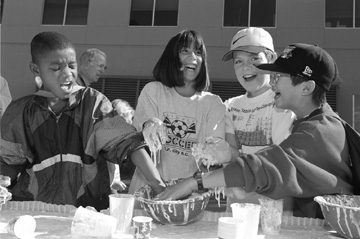 |
Family Science Tents
Hands-on, minds-on science for children from preschool through elementary school--and their parents. A place to take a break, let your young children imagine and explore, and see energy and science posters from students in our Bay Area schools.
How can you discover hidden shapes by rolling tennis balls? How tall can you build a leaning tower? How big a bubble can you make? Or how do you make one that is square? How do you bend a laser beam? Find out at the Family Science Tents. High-school students and Laboratory staff will be on hand to explain the science behind the fun and wow the kids with some of their favorite demonstrations. The tents are #2 on the map.
Science Discovery Theater
Colors of the Cosmos--11:00 and 12:30
Come see this Lawrence Hall of Science presentation, in which all the colors of the rainbow, and some beyond the rainbow, light up the auditorium. From glowing gases you'll learn how we know the composition of stars and the temperature of the sun. Find out how three colors combine to produce the many hues we see with our eyes. Then learn about invisible light, and be amazed at what your eyes are missing.
Two presentations in our main auditorium, #3 on the map.
Science Wanderers
They seek you out, ask you a science question, and reward you with a prize. You'll know them by their brightly colored lab coats. Who are these Science Wanderers? They are college students and future scientists from across the country, participating in the Energy Research Undergraduate Laboratory Fellowship (ERULF) program, sponsored by the Department of Energy. Ask them how they're liking their stay at the Lab.
An Electron's Adventure . . . on the ALS Patio
Become an electron! Create a photon! See secrets exposed by the special photon light you produce! Follow the path an electron takes as it is accelerated, bunched, bumped, and bent around the Advanced Light Source ring. The ALS is #7 on the map.
Science Passports
At the Welcome Center, pick up a special passport to the world of science. Then as you take your journey, get stamps at many of the stops along the way. There are special stamps at the four hubs and more than a dozen other places where you can get more!
Other Activities Kids May Enjoy . . .
- Adventures on the Web at the "World at Your Fingertips" hub
- Lab Firehouse (see attraction #14)
- Junior Gene Sleuths (see attraction #16)
Special Events
Special Preview Screening!Me & Isaac Newton.
A Michael Apted film produced by Clear Blue Sky Productions
Join us for a very special film event, one of the first public showings of this feature-length documentary by award-winning filmmaker Michael Apted. Director Apted is well known both for documentaries, such as the "Seven Up" series, and for full-length features, including "Gorillas in the Mist" and the latest James Bond thriller, "The World Is Not Enough." "Me & Isaac Newton" is a celebration of the lives of seven extraordinary scientists, one of them Berkeley Lab's own Ashok Gadgil.
One showing, at 2:00 in the Bldg. 50 auditorium.
Honoring East Bay Teachers
At 12:15 p.m., on the lawn behind the Welcome Center, the Laboratory will honor local math and science teachers who have made a difference in the lives of Bay Area students. Berkeley Lab works with many of these teachers to help advance science education in the classroom. Come cheer on the teachers and their Laboratory colleagues.
Career Opportunities Tent
Berkeley Lab is one of the largest employers in the Berkeley-Oakland area -- a great place to work and build a career. See for yourself at our Career Opportunities Tent, just behind the Welcome Center.
Human resources and benefits representatives will be available to talk about career and job opportunities at the Lab. Information about student assistant positions, internships, fellowships, and educational resources will also be available.
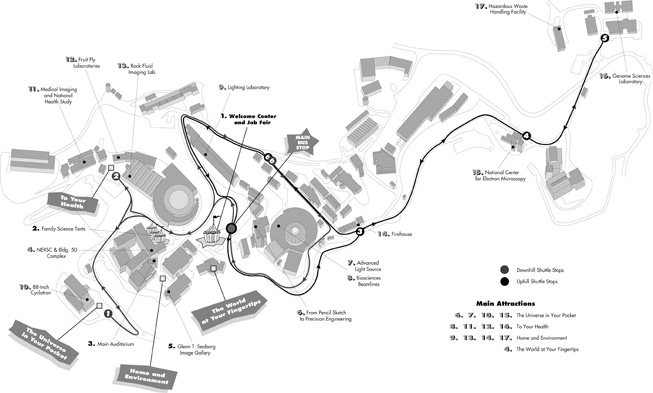 |
Bulletin Board
Lab Artist Designs New Pac Bell Stadium Cup
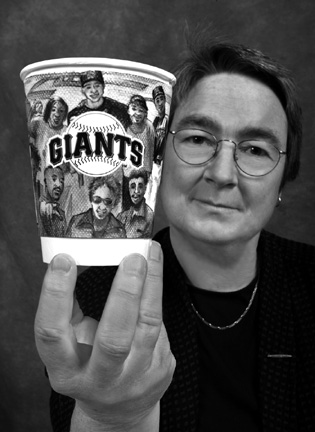 |
Although designed initially for the insulating layer on the cups, the stadium coffee vendor liked the picture so much that it is also being used for banners on coffee carts. Bailey got the job through her ties to Juma Ventures, a San Francisco firm which works with businesses to provide business experience for inner-city youngsters. Her artwork features some of those kids in all their diversity as they work as vendors for the coffee concessionaire at the ballpark. More of Bailey's artwork, also part of her work with Juma, also graces the Ben and Jerry's ice cream carts at Pac Bell Park and Candlestick Park, which the Giants called home until this season.
Trained as an advertising illustrator, Bailey was hired by the Lab as a geological illustrator in 1979. Since then, her talents have graced everything from the Runaround T-shirts to the historical display in the Bldg. 50 lobby. She's currently doing the graphic presentations for the upcoming Lab Open House on Saturday, May 6. For her extra-innings artistic efforts with the Giants, Bailey earned both a commission and four coveted tickets to one of the sold-out games in the intimate new park overlooking San Francisco Bay.
"My mom and I are big baseball fans, and anxious to see the new park," Bailey says, "so you bet we'll be there on April 15."
Lawrence Postdoctoral Fellowships Available: Deadline May 15th
The Lawrence Postdoctoral Fellowship Program is accepting applications through May 15, 2000. The fellowships provide challenging opportunities to conduct research in the Energy and General Sciences, Computing, and Biosciences. Fellows become integral members of Laboratory research teams, where they gain exposure to current national issues, share and exchange innovative ideas and techniques, and enhance their professional development. Fellows also have access to a valuable combination of outstanding professional staff, scientific equipment and facilities, and ongoing research and development available at other participating laboratories. One of the primary purposes of the fellowship is to identify, develop and enhance career opportunities and the overall competitive profile of members of groups historically underrepresented in their disciplines. More detailed information about eligibility requirements and application procedures is available at www.lbl.gov/Workplace/WFDO/ PostDoc.html.
VOICE MAIL: Date and Time-Stamp Feature Change
Great news! Telephone Services has announced a change in the date and time-stamp feature on lab telephones. Previously, this feature was only accessible by pressing "8" (or "t" for time) while listening to your messages. You may now choose whether you hear the date and time-stamp automatically, or only when the digit "8" is pressed.
If you would like to choose the option of hearing the date and time-stamp automatically, send e-mail to tsc@lbl.gov or call x7997. Be sure to include your name and extension. There is no charge for this service.
Softball League Meeting
On Wednesday 4/19 there will be an organizational meeting for LBNL Softball Managers in the lower cafeteria at noon. If you have an existing team or plan to form one, please attend. League play is scheduled to begin on May 17th and continue weekly until the end of August. If you have any questions or would like to join an existiing team, contact Steve Blair, x5927.
Golf Scores
Results from the LBNL Golf Club's Blue Rock Tournament played on March 24.
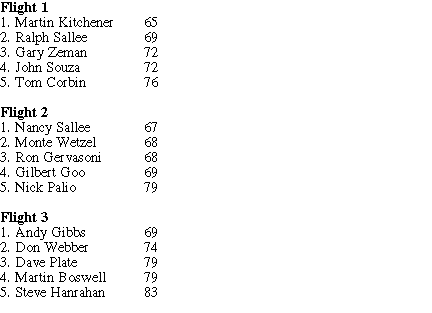
Daughters and Sons To Work Day
Thursday April 27, 2000
Employees are welcome to bring their children 9-15 years of age to the Laboratory for the day. There will be a morning and afternoon assembly in the Bldg. 66 Auditorium. Parents can plan for their children to attend one of these sessions. Seating is limited to 140. A pizza lunch in the Cafeteria area will be provided at a cost of $5.25. Please register to ensure we have pizzas for all parents and their children. Lunch will be followed by an assembly program for all students in the Bldg. 50 Auditorium. Parents are responsible for transportation to and from buildings and need to sign in their children for the assemblies.
Registration forms are available at www.lbl.gov/Workplace/DSTW
Currents Online
The full text and color photographs of Currents are published online at http://www.lbl.gov/Publications/Currents/. The site also allows users to do searches of past articles going back to 1994.
Calendar of Events
April 7 - 28, 2000
General Interest
TUES, APRIL 11
New Employee Orientation9:00 a.m., Bldg. 50 auditorium
Beach Cleanup at the Berkeley Marina
11:30 - 1:30, Meet at Bldg. 65
bus stop
THURS, APRIL 13
Eco Fair11:30 - 1:30, cafeteria lawn
TUES, APRIL 18
El Sobrante EBMUD Water Treatment Plant Tour11:30 - 1:30, Meet at Bldg. 65 bus stop
WED, APRIL 19
Softball Leaque Meeting12:00 p.m., lower cafeteria
THURS, APRIL 27
Daughters and Sons to Work DayAssembly at 9:30 a.m.-10:30 a.m., Bldg. 66 Auditorium; repeated at 3:00 p.m.-4:00 p.m. in Bldg. 50 Auditorium. LHS Assembly Program: "Quakes and Shakes." 1:00 p.m.-2:30 p.m. in Bldg. 50 Auditorium.
Dance classes are held every Monday from 12:00 to 1:00 on the lower level of Bldg. 51, with practices on Wednesdays at noon.
Martial arts classes are held every Monday and Wednesday from 5:00 to 6:15 p.m. at the same location.
Items for the calendars may be e-mailed to currents_calendar@ lbl.gov, faxed to X6641, or mailed to Bldg. 65B. The deadline for the April 28 issue is 5 p.m. Monday, April 24.
Seminars & Lectures
TUES, APRIL 11
Life Sciences Division"Bacteriorhodopsin: A Membrane Protein, An Ion Pump, And The Muse Of New Methodology In Structural Biology", will be presented by Robert Glaeser, LBNL, UCB
4:00 p.m., Bldg. 84
Refreshments precede the seminar
WED, APRIL 12
LBNL Macintosh Users Group"Scientific Data Visualization Tools (For Macs & All Platforms)" will be presented by Research Systems of Boulder, CO.
Main meeting 11:00 a.m.-noon, Q&A noon-1 p.m., Bldg. 90-3148.
Bring lunch (refreshments also provided)
THURS, APRIL 13
Fluid Mechanics Seminar"Influence of Contact-Line Conditions On Evolution Of Solidification Fronts", will be presented by Dr. Vladimir S. Ajaev, Stanford University
4:00 p.m., 3110 Etcheverry Hall
Cookies & Coffee served at 3:30 p.m.
FRI, APRIL 14
Center For Beam Physics Seminar"Recent Progress in Heavy Ion Inertial Confinement Fusion," will be presented by Roger Bangerter, LBNL
10:30 a.m., Bldg. 71
Refreshments precede the seminar
FRI, APRIL 21
CBP Seminar"Status of the PEP-II B factory," will be presented by Mike Zisman, LBNL
10:30 a.m. Bldg. 71
Refreshments precede the seminar
MON, APRIL 24
Physics Department Colloquium"Correlation, Decoherence, Dephasing & Relaxation in Condensed Matter" will be presented by Professor Daniel S. Chemla
4:30 p.m., 1 LeConte Hall
Nominations for Outstanding Science and Math Teachers at Open House
At the May 6 Open House, Berkeley Lab will honor local science and math teachers who have worked with the Laboratory or have made a difference in the lives of children of Lab employees.
Lab employees can nominate a teacher at any grade level, from kindergarten to university, to be recognized as "outstanding."
The awards will be presented the day of the Open House in a special ceremony at 12:15 p.m. outside the cafeteria.
Nominations may be sent by e-mail to Rollie Otto at rjotto@lbl.gov., with a backup copy to Reid Edwards, RAEdwards@lbl.gov. Please include the teacher's name and address, school affiliation and telephone number, and a short statement on why that teacher has been so special in your child's education. Nominations must be recieved by April 14.
For more information contact Rollie Otto at X5325.
Flea Market
Auto / Supplies
`99 SUBARU Outback Wagon, AWD, 16K (still new), $19,500, Meredith, X4453, (925) 376-0257`96 DODGE RAM 3500 Van Camper, 19ft Horizon, like new, auto, fully loaded, dual air cond, kitchen, wc, shower, microwave, oven, waterheater, 2 queen sz beds, sleeps 4, new batt/tires/brakes, $17,900/bo, Jens, X6174
`93 HONDA Civic EX, 2 dr, 5 spd, snrf, Alpine cd/ alrm/ac/pw/pd/cc, 77K, exc cond, new tires, $7,400, Danielle X4555, (650) 341-7599, after 8 pm
`87 PLYMOUTH GRAND VOYAGER LE mini-van, 7 psgr, 119K, V6, auto, ac/pwr steer/windows/locks/seat, tilt wheel, cruise cntrl, roof rack, am/fm/cass, orig owner, no accidents, all maint records avail, gd cond, $2,950, Ron, 486-4410
`84 VOLVO GL, 4 dr sedan, blue, 189K, at,ac,ps,pl,pw, sun roof, am/fm cass, new steering rack, timing belt replaced, runs well, smoked, moving 4/16, $2150, Roy, (650) 926-8524
`83 NISSAN STANZA, hatchback, 4 dr, auto, 155k, am/fm, runs gd, $700, Zhou, X7267
`82 DODGE Power Ram, 4x4, SE-150, ac/cruise cntrl/tilt/am/fm cass/carpet kit, shell, $2,500/bo, Rocky, X6026, (209) 823-9223
`65 MERCEDES BENZ 220 SE, 2 dr, 4 pass coupe, exc cond, see to appreciate, 85K, $12,000/bo, Neil, (415) 383-7453
Motorcycles
`94 KAWASAKI EX 500 NINJA, exc cond, roller steering head bearings, new filtron air filter, new tires, EBC full floating front brake rotor, nice handling, adult owned/maint, wine color, $2,600/bo, Rich, X7031 (till) 4:00 pm, (925) 689-1714Housing Available
BERKELEY, 1 bdrm apt, furn, pleasant, quiet, near UC/LBL, trans, avail now to UC/LBL visitors by wk, mo, 848-1830BERKELEY, large, furn rm in lovely Julia Morgan brown shingle house, quiet, north of Univ Ave, ltd kitchen privil, near shuttle/campus/BART, ideal for visiting scholar, non-smoking, $450/mo, avail 5/1, Rob, 843-5987
N. BERKELEY SUBLET, spacious 1 bdrm flat, fully furn, near BART, restaurants, shops, hardwd flrs, coved ceilings, safe, plenty of parking, garden, view of the GG Bridge, sublet to responsible, quiet person, 4-17-5/17, $750.00, dep nego, Alex, (415) 365-3625 work, 559-6992
ELMWOOD, woman sought to share elegant 11 rm house w/ 2 men, 1 woman, non-smoking prof, mstr bdrm w/ frplc/huge closet, piano, yellow Lab, laundry, sauna, hardwd floors, exc loc, $695-750/mo + dep, shared exp, Tony, 841-4480
KENSINGTON, 1 bdrm apt, furn, near BART, shopping, great area, bus line to Cal campus, avail 5/3 - 7/17, $500/mo, plus util, Bob, X5363, 524-0634
PLEASANT HILL, Walnut Creek/Lafayette border, modern, nicely furn home, 3 bdrms, formal dining rm, lge fam rm, lge deck, all amen, exc loc, near trans/BART, mid-May to late June, 4-6 weeks, $600/wk (time & rent nego), non-smoker, Natalie, (925) 934-0759, Werner, (925) 937-6433
Housing Wanted
LAB RESEARCHER/schoolteacher couple seek in-law apt. or cottage for long term rental, ideal tenants, Chris, X4134, 841-2461NEW YORK UNIVERSITY faculty visiting LBL is looking for a 1 or two bdrm from May 15 to 30 in Berk or vicinity, Prof. Porrati, (212) 998-7733, (massimo.porrati@nyu.edu)
SUMMER HOUSING needed for visiting scholar from Spain, near lab, from 7/1 to 9/30, Carlos, CODeSolorzano@lbl.gov
VISITING EPIDEMIOLOGIST seeks 2 to 3 bdrm, 2 ba house in Albany, Kensington, Berk, Oakland, 1 to 2 years, begin in May, non-smoker, no pets, quiet/responsible; flex on start date, rent, X5910 or X6591
VISITING SCIENTIST w/ 2 kids, (13 & 11), seeks 1 or 2 bdrms, 2 wks from 7/3 to 7/16, Kenzi, X6759
Miscellaneous
AQUARIUM, 30 gallon hex w/stand, Fluval 203, Hagen 201 pwrhead/undergravel filter (over $300 retail) $100/bo, Dave, X4506BIKE TRAILER, Rhode Gear, for 1 or 2 kids, very little use, twins, one loved it, one hated it, $150/bo, Jonathan, X4148
ESTATE SALE, Sat, 4/15, 11:30 am to 4:00 pm, lovely maple dinette set w/ leaf + 6 chairs, futon, wooden tables, chairs, Weber BBQ, redwood BBQ table w/ bench, bedrm set, gardening tools, and more!, 2018 Coalinga Ave, Richmond, 653-6964, 235-2136
FISHPOND, fiberglass, gd shape, 9 ft long, 5+ ft wide, 1.5 ft deep, $125, Dennis, X 7859, (925) 939-2006, eves
LATHE 10" Atlas, Timkin roller bearings, 3 jaw chuck, 4 jaw chuck, some tooling, sturdy wooden table, no quick change but change gears, very gd cond, $650/bo; air compressor, Craftsman direct drive, oiless; 20 gallon tank, gd cond for air tools, $150/bo; old Murrey 3 HP rotary mower, runs gd, no grass catcher, $25/bo, Rich, X7031(till) 4:00 pm, (925) 689-1714
PLAY STRUCTURE, wooden swing set, 2 swings/trapeze/bars/rope ladder/slide/great cond, $50, Neil, X6479
WOODEN BLINDS, 2" white Graber, 65 3/4" W x 58 3/8" H (1), 25 1/2" W x 58 3/8" H (2), $100. for all 3 blinds, Sara/Harvard, 526-5347
Vacations
PARIS, near EIFFEL TOWER, elegant, furn 2 bdrm apt avail per wk/mo, color pics avail upon request, 848-1830SALT SPRING ISLAND, BC Canada, 3 bdrm house in a 1 acre private wood, $800/wk, ferry to Vancouver, Victoria; John, 849-1051
SO LAKE TAHOE, spacious chalet in Tyrol area, close to Heavenly peek of the lake from front porch, fully furn, sleeps 8+, sunny deck, pool, spa in Club House, near casinos, shopping, $155 per day, two day min, Angela, X7712, Pat, Maria, 724-9450
Wanted
CRIB, white metal, exc shape, $25, Francesca, X7193KARASTAN hall runner, 2-1/2 x 11 feet, predominantly maroon color, traditional pattern, exc shape, $50, Rich, X5842
SAXAPHONE for beginner, Bob, X7355, 527-1927
METAL LATHE, ~10" swing, in working cond or close to it, Zach, X7765, 531-3435
SEEKING A RIDE to LBL from Martinez, Concord, Pleasant Hill area, (exchange student), Emery, (925) 370-0737, anytime
Flea Market Policy
Ads are accepted only from LBNL employees, retirees, and onsite DOE personnel. Only items of your own personal property may be offered for sale.
Submissions must include name, affiliation, extension, and home phone number.
Ads must be submitted in writing only -- via e-mail (fleamarket@lbl.gov), fax (X6641), or delivered/ mailed to Bldg. 65B. Ads run one week only unless resubmitted in writing, and are repeated only as space permits.
The deadline for the April 28 issue of Currents is Thursday, April 20.
